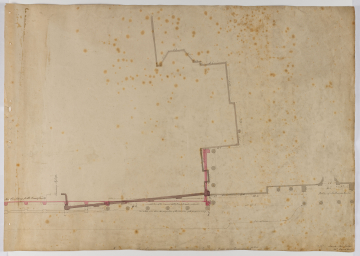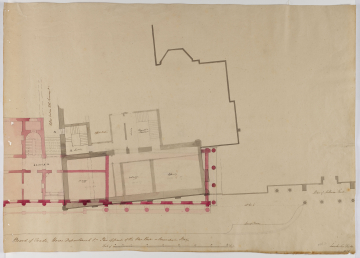
Browse
- Sir John Soane office drawings: the drawings of Sir John Soane and the office of Sir John Soane
Reference number
Purpose
Aspect
161 Part plan of the Home Office with new design overlaid and rough plan of line of frontages along Whitehall
162 Plan of part of the One Pair or Principal Story
163 Plan of the Board of Trade and Privy Council Offices and the Home Office with pavilion overlaid
164 Site plan with new Board of Trade and Privy Council Offices overlaid
Scale
Inscribed
161 labelled: New Buildings for the / Board of Trade, Line of Pavement, Board of Trade, Treasury, Lord Melbournes, Horse Guards, Pay Office, Admiralty, Charing Cross and dimensions given
162 Board of Trade, labelled: 6.0 above AA, A, Passage leading to the Treasury &c, A, Landing, Office Keeper, Landing, Principal / Staircase, Mr Capper / 1 P[ai]r, Mr Plasket / 1 Pr, Library, Ab[ou]t 60'0'', Line of Paving, Portico of Melbourne House
164 labelled: Private Houses, Fludyer Street, Foreign Office, Downing Square, Line of Old Building (twice), Downing Street, Stable Yard, Stables &c, Staircase / leading to the / Treasury, Leading to the Park, Area, (pencil) Park, Treasury Passage, Treasury, Home Department, Melbourne House, Whitehall, Board of Trade, (pencil) Hall (3 times), Council Office, King Street, Lincolns Inn Fields and some dimensions given
Signed and dated
- (160) Lincolns Inn Fields / 30th March 1825 (161) 31st March 1825 (162) Lincolns Inn Fields / 1825
Medium and dimensions
Hand
Watermark
Notes
Drawings 160-162 show the outline of the former Home Office and Melbourne House (now Dover House) and, overlaid in pink wash, the line of the new building including the Home Office. Drawing 163 is more detailed, giving the internal layout of the old and new buildings. Drawing 164 probably dates to a similar time - it shows the old Foreign Office in Downing Square prior to Soane's alterations to that building (see Soane: Office of Works: London: Old Foreign Office, Downing Street, 1825), as well as the outline of the intended new building on the south side of Downing Street.
Soane was questioned extensively by the Select Committee about the 'pavilion' (the projecting part of the building in front of the new Home Office). It was estimated that the pavilion would project 'about 12 feet' in front of Melbourne House and, while Soane did not explicitly state it, he produced drawings to demonstrate the problem (1828 Report). According to his testimony, 'there was a great deal said upon the subject; I observed, that perhaps the effect might not be displeasing, but, as far as convenience was concerned, every one must condemn it.'
Mr Plasket was Chief Clerk of the Home Department. Mr Capper was another civil servant at the Home Office.
Level
Sir John Soane's collection includes some 30,000 architectural, design and topographical drawings which is a very important resource for scholars worldwide. His was the first architect’s collection to attempt to preserve the best in design for the architectural profession in the future, and it did so by assembling as exemplars surviving drawings by great Renaissance masters and by the leading architects in Britain in the 17th and 18th centuries and his near contemporaries such as Sir William Chambers, Robert Adam and George Dance the Younger. These drawings sit side by side with 9,000 drawings in Soane’s own hand or those of the pupils in his office, covering his early work as a student, his time in Italy and the drawings produced in the course of his architectural practice from 1780 until the 1830s.
Browse (via the vertical menu to the left) and search results for Drawings include a mixture of Concise catalogue records – drawn from an outline list of the collection – and fuller records where drawings have been catalogued in more detail (an ongoing process).










